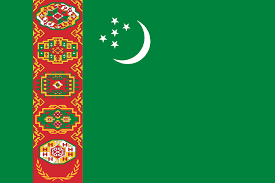Language/Turkmen/Grammar/Common-Prepositions
| ◀️ Famous Landmarks — Previous Lesson | Next Lesson — Using Conjunctions ▶️ |
In this lesson, we will learn common Turkmen prepositions, such as in, on, at, and with. Prepositions are words used to show the relationship between a noun or pronoun and other words in a sentence. They help provide a clear understanding of where one object is in relation to another. As you learn these prepositions, we will also include some cultural information and interesting facts about Turkmenistan to make the lesson more engaging.
Take a moment to explore these relevant pages as you conclude this lesson: Forming Questions & 0 to A1 Course.
Introduction to Prepositions
In the Turkmen language, prepositions are called "önümler". As in English, they are essential for building sentences and expressing relationships between words. Some important prepositions you'll encounter in this lesson include:
- içinde (in)⠀⠀⠀⠀⠀⠀
- üzerinde (on)⠀⠀⠀⠀⠀⠀
- at (at)⠀⠀⠀⠀
- bilen (with)⠀⠀⠀⠀⠀⠀
These prepositions will help you convey important information about location, time, and other relationships in your sentences. To better understand how they function in sentences, we will look at some examples using each preposition.
Inside (içinde)
The preposition "içinde" means "inside" in Turkmen. It indicates that something is contained within something else. For example:
| Turkmen | Pronunciation | English |
|---|---|---|
| Kitap şkafda içinde. | /kitap ʃkafdɑ iʧinde/ | The book is inside the drawer. |
| Koşgiň içindeki palta. | /koʃgiŋ iʧindeki pɑltɑ/ | The coat inside the wardrobe. |
Turkmenistan is known for its beautiful handmade carpets, which are commonly found inside homes. These carpets, called "halı", are a major symbol of Turkmen culture and a source of national pride.
On (üzerinde)
"Üzerinde" means "on" in Turkmen. It is used to indicate that something is on top of or above something else. For example:
| Turkmen | Pronunciation | English |
|---|---|---|
| Telefon masanyň üzerinde. | /telefon masanəɲ yzeɾinde/ | The phone is on the table. |
| Çyra aýnaň üzerinde. | /ʧyɾɑ aɪnaŋ yzeɾinde/ | The candle is on the mirror. |
In Turkmenistan, it is customary to display the national flag on government buildings, schools, and various other public spaces. The flag features five stars, representing the five provinces of the country, and a traditional carpet design, symbolizing the rich Turkmen culture.
At (at)
"At" is used in both English and Turkmen to express a specific location, time, or direction. Some examples include:
| Turkmen | Pronunciation | English |
|---|---|---|
| Men sagat 3 at uniwersitetde. | /men sagat 3 at uniweɾsitetde/ | I am at the university at 3 o'clock. |
| Aý/ýyldaň ertesi söhbetde atlar. | /aɪ/əɪldaɲ eɾtesi sohbetde atlɑɾ/ | They will meet at the conversation the day after tomorrow. |
It is interesting to note that Turkmenistan is home to the world-renowned Akhal-Teke horse breed. These horses are known for their speed, endurance, and intelligence, and have long been associated with the Turkmen people. The Akhal-Teke horse even appears on the emblem of the country, symbolizing the strong link between the Turkmen people and their beloved horses.
With (bilen)
"Bilen" means "with" in Turkmen, and it is used to express the presence or accompaniment of someone or something else. For example:
| Turkmen | Pronunciation | English |
|---|---|---|
| Men Mari bilen gitdim. | /men maɾi bilen gitdim/ | I went with Mary. |
| Şu hapa çay bilen içeris. | /ʃu hɑpɑ ʧaɪ bilen itʃeris/ | Drink this tea with lemon. |
Turkmenistan is famous for its hospitality and warm welcome to visitors. When you visit a Turkmen home, you are often greeted with aromatic tea, served with sweets and traditional Turkmen bread, called "çörek". Sharing a meal with someone is a sign of friendship and community in Turkmenistan.
Practice Exercise
Now, let's practice using these prepositions in some sentences. Fill in the blanks with the appropriate preposition "içinde", "üzerinde", "at", or "bilen":
1. Daşary ___________ köpek ýaşaýar. 2. Şu pyçak ___________ alma kesýär. 3. Şu kärhanasyň ___________ işgärler meşgullar. 4. Gije sagat 10 ___________ uzakdaşlygy galdyryp bolşýar.
Conclusion
In this lesson, we learned some common Turkmen prepositions and their usage in sentences. Understanding and using prepositions correctly will help you communicate more effectively in Turkmen, allowing you to express relationships between words and ideas clearly. As you continue learning Turkmen, don't forget to practice regularly and immerse yourself in the culture and traditions of Turkmenistan. Good luck and happy learning!
Upon wrapping up this lesson, take a look at these related pages: Give your Opinion & Verbs.
Other Lessons
- Forming Questions
- Some Continous Moods
- Personal pronouns
- Ordinal Numbers
- Pronouns
- Conditional Mood
- Plurals
- Basic Verb Conjugation
- Using Conjunctions
- How to Use Be
Sources
| ◀️ Famous Landmarks — Previous Lesson | Next Lesson — Using Conjunctions ▶️ |

